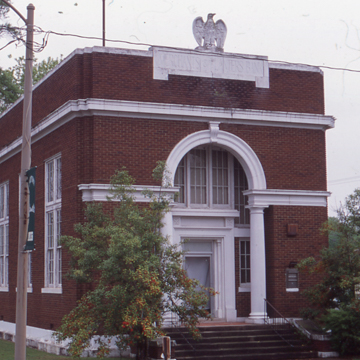The White River flows just three blocks from this building, and during the Great Mississippi Flood of 1927 (the White is a tributary of the Mississippi) much of downtown Clarendon was destroyed. Only the courthouse (MO3) and a few of the better-built properties, such as this one, survived. The red brick building with white trim has a finely proportioned facade with its entrance recessed within a tall arch carried on Tuscan columns, and its quiet classicism complements Thompson’s more showy courthouse. A stone eagle with outstretched wings perches on the roofline panel inscribed with the bank’s name. Clarendon was an important industrial port supplying staves, barrels, oars, buttons, and pearls. This is one of several buildings that have lost their original function in a downtown and region where an economy based on agriculture and the river trade has changed or largely disappeared. The Clarendon Tourist Welcome Center now occupies the building.
You are here
Historic Merchants and Planters Bank
If SAH Archipedia has been useful to you, please consider supporting it.
SAH Archipedia tells the story of the United States through its buildings, landscapes, and cities. This freely available resource empowers the public with authoritative knowledge that deepens their understanding and appreciation of the built environment. But the Society of Architectural Historians, which created SAH Archipedia with University of Virginia Press, needs your support to maintain the high-caliber research, writing, photography, cartography, editing, design, and programming that make SAH Archipedia a trusted online resource available to all who value the history of place, heritage tourism, and learning.





















